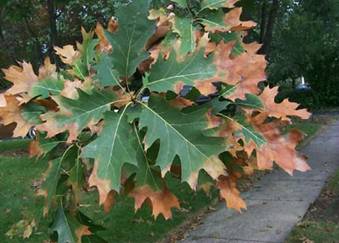Bacterial Leaf Scorch
Natural History

Red oak with BLS symptoms | Photo credit: Bugwood.org
Bacterial leaf scorch is caused by the bacterium, Xylella fastidiosa. This bacterium is limited to the xylem of infected hosts, and is transmitted by xylem-feeding insects such as leafhoppers, sharpshooters, and spittlebugs. The pathogen disrupts vascular function. As a result, damage that is similar to drought damage begins to appear in mid-summer.
Infected trees display leaves with scorching symptoms – including marginal necrosis and chlorosis. Leaves may eventually become completely brown and remain attached. Chronic infection can lead to stunting, dieback, and witch's brooms. The host range is very wide, but the disease is most commonly observed in Florida on oaks (especially turkey oak), sycamore, sweetgum, and elms. Control is not common on trees, but anti-biotic injections can be useful.
